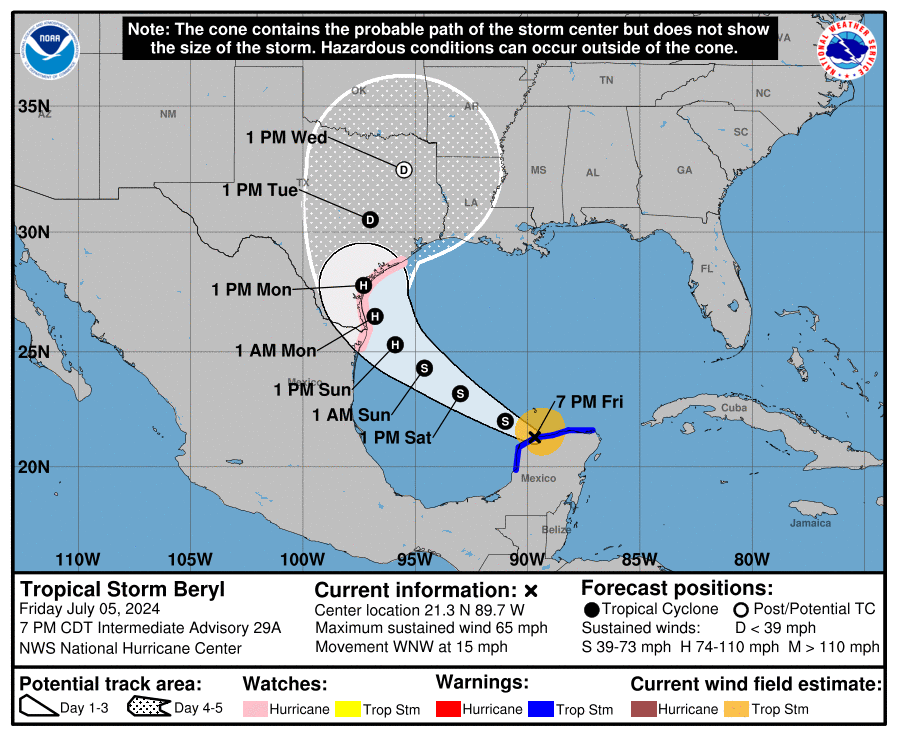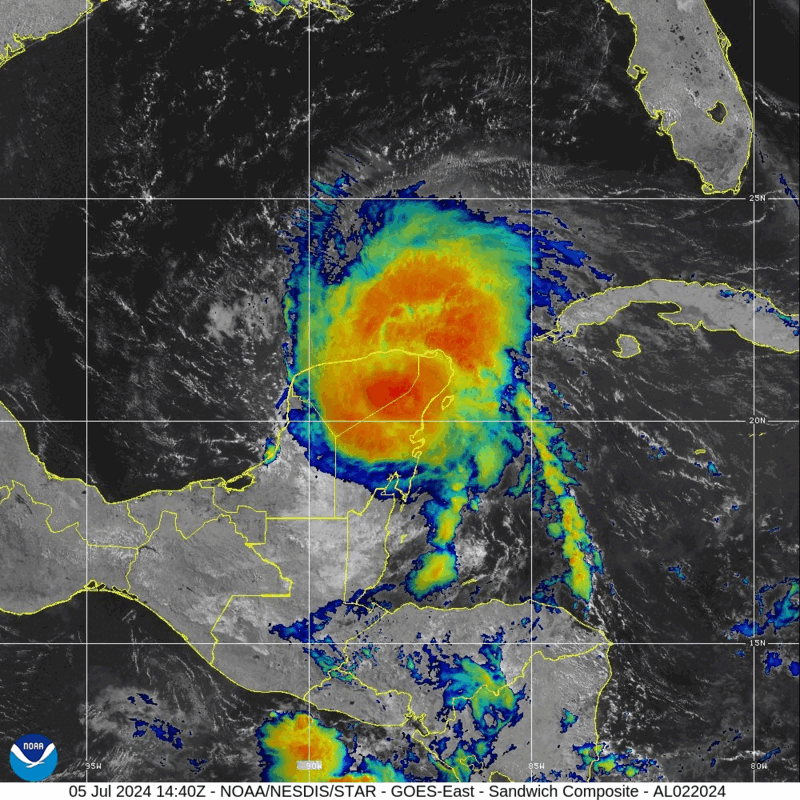As first predicted here at The Gate With Brian Cohen, the Gulf Coast of Texas is next in the path of what is once again Tropical Storm Beryl in July 2024, which was the first major hurricane of the 2024 season. If the Gulf Coast of Texas is in your travel plans over the next few days, you may want to consider delaying your travel — or, at least, keep yourself updated as to the latest information pertaining to the weather.
Texas is Next: Tropical Storm Beryl July 2024 Travel Alert
Maximum sustained winds of Tropical Storm Beryl — which is currently approximately 580 miles east southeast of Brownsville in Texas and moving west northwest at a speed of 15 miles per hour — are at 65 miles per hour, which means that it is currently a strong tropical storm. Possible landfall of what is expected to once again become a hurricane is expected as early as just before noon on Monday, July 8, 2024.

At least eleven fatalities have been reported between when the first landfall of Hurricane Beryl occurred shortly after 11:00 in the morning Eastern Daylight Time on Monday, July 1, 2024 on Carriacou Island in Grenada in the Caribbean Sea with maximum winds of 150 miles per hour; and when the second landfall occurred at approximately 6:00 in the morning Central Daylight Time yesterday, Thursday, July 4, 2024 northeast of Tulum in Mexico as a Category 2 hurricane with maximum winds of 110 miles per hour. Widespread substantial destruction has been reported in Grenada, Jamaica, and Saint Vincent and the Grenadines; and hundreds of people have been without electrical power.
Hurricane Beryl is the strongest known hurricane to pass through the Grenadine Islands, according to data from the National Oceanic and Atmospheric Administration of the Department of Commerce of the United States since records were first kept in 1851.
After emerging once again back out on the open warm waters of the Caribbean Sea, Hurricane Beryl strengthened to Category 5 status with sustained winds of 165 miles per hour. Fortunately, the speed of the forward motion of the storm has been between 15 miles per hour and 20 miles per hour, because a slower movement would have surely meant even more destruction in the path of the storm.
A hurricane to form as far east as Hurricane Beryl did — along with its intense strengthening — is unusual for this time of year. Hurricane Beryl is the earliest tropical storm system to achieve Category 4 strength in June; and it is the earliest tropical storm system to achieve Category 5 strength in July. This pattern normally starts to occur sometime in late July.
A Hurricane Watch is in effect for:
- The Texas coast from the mouth of the Rio Grande northward to Sargent
- The northeastern coast from mainland Mexico from Barra el Mezquital to the mouth of the Rio Grande
A Tropical Storm Warning is in effect for:
- The coast of the Yucatan Peninsula of Mexico west of Cabo Catoche to Campeche
A Storm Surge Watch is in effect for:
- The Texas coast from the mouth of the Rio Grande northward to Sargent
Significant precipitation of up to 15 inches is possible in across portions of the Texas Gulf Coast and eastern Texas, which is expected to result in urban flooding and flash flooding.
Rough surf and strong rip currents are currently affecting Cuba, and the Cayman Islands, and the Yucatan Peninsula of Mexico. A dangerous storm surge of as high as five feet above normal is expected to contribute to the aforementioned significant flooding of portions of southeastern Texas.
Tropical Storm Beryl is expected to strengthen back to a hurricane prior to landfall in Texas. Concerns in much of the state of Texas should be prepared for the potential significant precipitation and gusty winds — with an occasional isolated tornado — of Hurricane Beryl. Portions of southeastern Oklahoma, southwestern Arkansas, and western Louisiana should also prepare for significantly inclement weather as Tropical Storm Beryl becomes a strong low pressure system that will still be capable of producing inches of rain and windy conditions.
Flight Waivers, Delays, and Cancellations
If you are traveling to or from the Gulf Coast of Texas, expect delays and cancellations of flights. Keep up to date on the latest information pertaining to this tropical weather system which may adversely affect your travel plans. Better yet, postponing or canceling your trip might be a better option — no matter which mode of travel you plan on taking.
If you have a flight scheduled, your flight may be delayed or canceled — and you may be eligible for a waiver of a fee to change your itinerary. If you are driving in any of these areas, watch out for deteriorating weather conditions and traffic problems.
Here are twelve airlines which have issued travel alerts as a result of this tropical weather system:
- American Airlines has issued travel alerts for:
- Cancún, Cozumel, Merida, and Tulum in Mexico for Wednesday, July 3, 2024 through Saturday, July 6, 2024; and Thursday, July 11, 2024 is the last day on which tickets must be reissued and rebooked travel must begin.
- Argyle in Saint Vincent and the Grenadines, Bridgetown in Barbados, Grand Cayman, Grenada, Saint Lucia, and three airports in Jamaica for Saturday, June 29, 2024 through Friday, July 5, 2024; and Wednesday, July 10, 2024 is the last day on which tickets must be reissued and rebooked travel must begin.
- Delta Air Lines has issued travel alerts for:
- Five airports in Texas for Sunday, July 7, 2024 through Tuesday, July 9, 2024; and Friday, July 12, 2024 is the last day on which tickets must be reissued and rebooked travel must begin.
- Belize, Cancún, Grand Cayman Island, Montego Bay, Kingston, and Tulum for Monday, July 1, 2024 through Friday, July 5, 2024; and Wednesday, July 10, 2024 is the last day on which tickets must be reissued and rebooked travel must begin.
- United Airlines has issued travel alerts for:
- Five airports in Texas for Sunday, July 7, 2024 through Tuesday, July 9, 2024; and Tuesday, July 16, 2024 is the last day on which tickets must be reissued and rebooked travel must begin.
- Grand Cayman, Montego Bay, and four cities in Mexico for Monday, July 1, 2024 through Saturday, July 6, 2024; and Sunday, July 14, 2024 is the last day on which tickets must be reissued and rebooked travel must begin.
- Alaska Airlines has issued travel alerts for Cancun and Ladyville in Belize for Tuesday, July 2, 2024 through Friday, July 5, 2024; and Wednesday, July 10, 2024 is the last day on which tickets must be reissued and rebooked travel must begin.
- Southwest Airlines has issued travel alerts for:
- Corpus Christi and Harlingen in Texas for Saturday, July 6, 2024 through Tuesday, July 9, 2024; and Tuesday, July 23, 2024 is the last day on which tickets must be reissued and rebooked travel must begin.
- Cancún and Cozumel in Mexico and Belize City in Belize for Wednesday, July 3, 2024 through Friday, July 5, 2024; and Friday, July 19, 2024 is the last day on which tickets must be reissued and rebooked travel must begin.
- JetBlue Airways has issued travel alerts for Belize City, Cancún, Tulum, Grand Cayman, Kingston, and Montego Bay for Monday, July 1, 2024 through Friday, July 5, 2024; and Monday, July 8, 2024 is the last day on which tickets must be reissued and rebooked travel must begin.
- Frontier Airlines has issued travel alerts for Bridgetown, Montego Bay, and Cancún for Wednesday, July 3, 2024 through Saturday, July 6, 2024.
- Spirit Airlines has issued travel alerts for:
- Cancún for Wednesday, July 3, 2024 through Friday, July 5, 2024; and Wednesday, July 10, 2024 is the last day on which tickets must be reissued and rebooked travel must begin.
- Kingston and Montego Bay for Tuesday, July 2, 2024 through Thursday, July 4, 2024; and Wednesday, July 10, 2024 is the last day on which tickets must be reissued and rebooked travel must begin.
- Sun Country Airlines has issued a travel alert for Cancún for Thursday, July 4, 2024 through Friday, July 5, 2024; and Friday, July 12, 2024 is the last day on which tickets must be reissued and rebooked travel must begin.
- Air Canada has issued travel alerts for:
- Cancún and Tulum for Friday, July 5, 2024.
- Aeromexico has issued travel alerts for:
- La Havana and Santo Domingo for Tuesday, July 2, 2024 through Wednesday, July 3, 2024; and Monday, July 8, 2024 is the last day on which tickets must be reissued and rebooked travel must begin.
- Cancún, Cozumel, Chetumal, Mérida, and Tulum for Wednesday, July 3, 2024 through Friday, July 5, 2024; and Monday, July 8, 2024 is the last day on which tickets must be reissued and rebooked travel must begin.
- KLM Royal Dutch Airlines has issued travel alerts for Belize, Cancún, Grand Cayman Island, Montego Bay, Kingston, and Tulum for Monday, July 1, 2024 through Friday, July 5, 2024; and Wednesday, July 10, 2024 is the last day on which tickets must be reissued and rebooked travel must begin.
Final Boarding Call
Be sure to contact your airline or transportation provider for the latest information pertaining to your travels — if they are adversely affected — and please: travel safely.
Source: The National Oceanic and Atmospheric Administration of the Department of Commerce of the United States.
